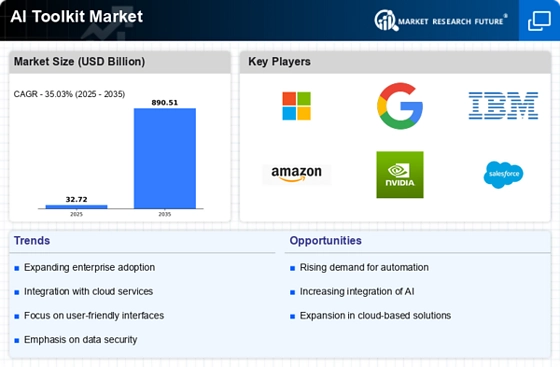Rising Demand for Automation
The AI Toolkit Market is experiencing a notable surge in demand for automation across various sectors. Organizations are increasingly recognizing the potential of AI tools to streamline operations, enhance productivity, and reduce human error. According to recent data, the automation market is projected to grow at a compound annual growth rate of over 25% in the coming years. This trend is driven by the need for efficiency and cost reduction, prompting businesses to invest in AI toolkits that facilitate automated processes. As companies seek to remain competitive, the integration of AI solutions into their workflows becomes essential, thereby propelling the growth of the AI Toolkit Market.
Growing Emphasis on Data Security
In the AI Toolkit Market, the increasing emphasis on data security is becoming a pivotal driver. As organizations adopt AI solutions, concerns regarding data privacy and security have escalated. Regulatory frameworks are evolving, necessitating that AI toolkits incorporate robust security measures to protect sensitive information. The market for data security solutions is projected to reach over 200 billion dollars by 2026, indicating a strong demand for secure AI applications. This focus on security not only influences the design and functionality of AI toolkits but also shapes consumer trust and adoption rates. Thus, the integration of security features within AI toolkits is essential for fostering growth in the AI Toolkit Market.
Advancements in Machine Learning Technologies
The AI Toolkit Market is significantly influenced by rapid advancements in machine learning technologies. These innovations enable the development of more sophisticated AI tools that can analyze vast amounts of data, learn from patterns, and make informed decisions. The machine learning sector is expected to witness substantial growth, with estimates suggesting a market size exceeding 100 billion dollars by 2027. This evolution not only enhances the capabilities of AI toolkits but also broadens their applicability across industries such as finance, healthcare, and manufacturing. Consequently, the proliferation of machine learning technologies is a key driver for the AI Toolkit Market, as organizations seek to leverage these tools for competitive advantage.
Expansion of AI in Small and Medium Enterprises
The AI Toolkit Market is witnessing a significant expansion as small and medium enterprises (SMEs) increasingly adopt AI technologies. Historically, AI solutions were primarily accessible to large corporations due to cost and complexity. However, the emergence of affordable and user-friendly AI toolkits is enabling SMEs to harness the power of AI. Recent studies indicate that nearly 60% of SMEs are planning to implement AI solutions within the next two years. This trend is likely to drive innovation and competition within the AI Toolkit Market, as more players enter the space to cater to the unique needs of smaller businesses. The democratization of AI technology is thus a crucial factor in the market's growth.
Integration of AI with Business Intelligence Tools
The AI Toolkit Market is increasingly characterized by the integration of AI with business intelligence (BI) tools. This convergence allows organizations to derive actionable insights from data more effectively. As businesses strive to make data-driven decisions, the demand for AI-enhanced BI solutions is on the rise. Market analysis suggests that the BI market is expected to grow to over 30 billion dollars by 2025, with AI integration playing a significant role in this expansion. The ability of AI toolkits to enhance data visualization, predictive analytics, and reporting capabilities is driving their adoption among enterprises. Consequently, the synergy between AI and BI tools is a vital driver for the AI Toolkit Market.


















Leave a Comment